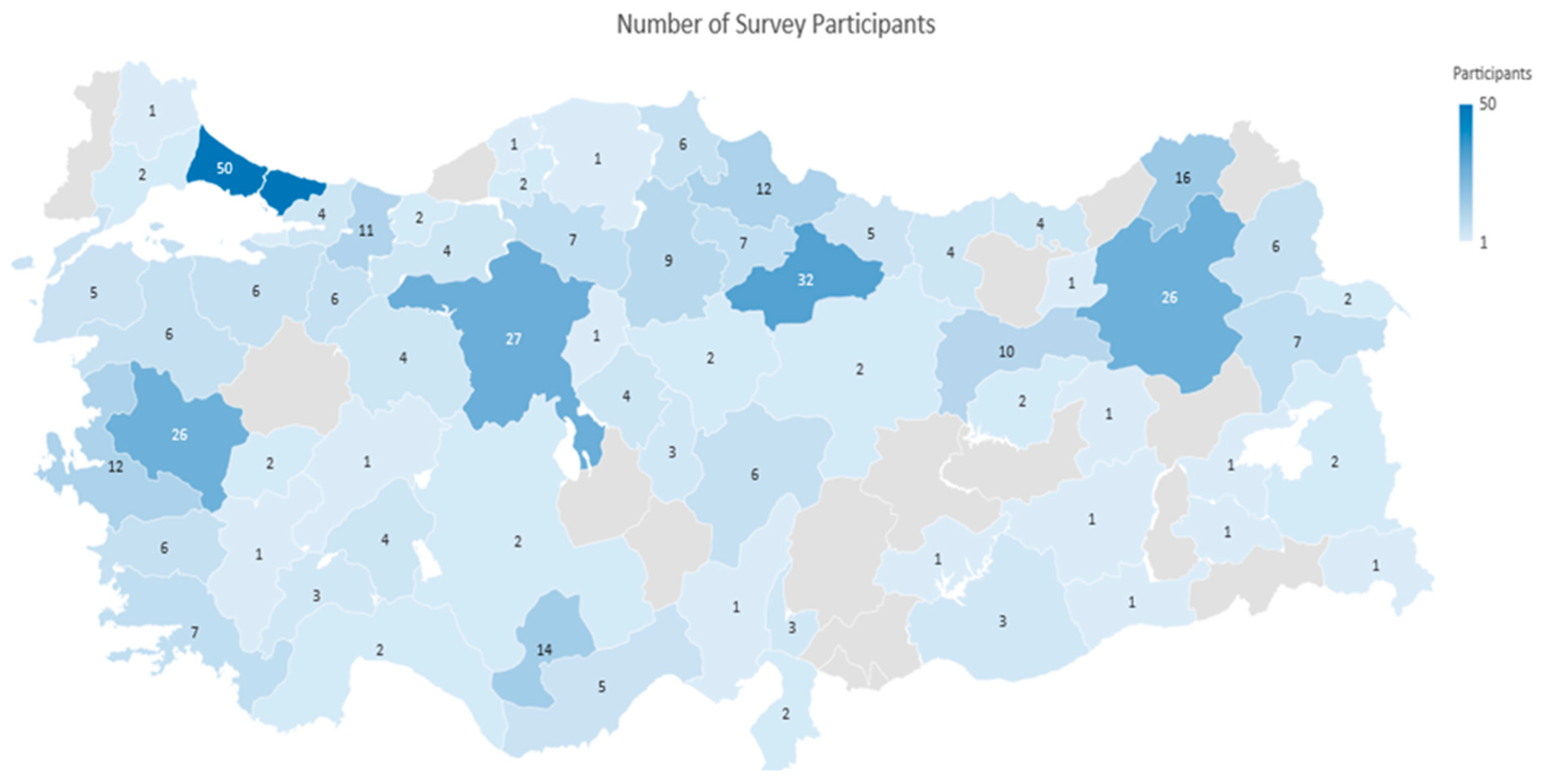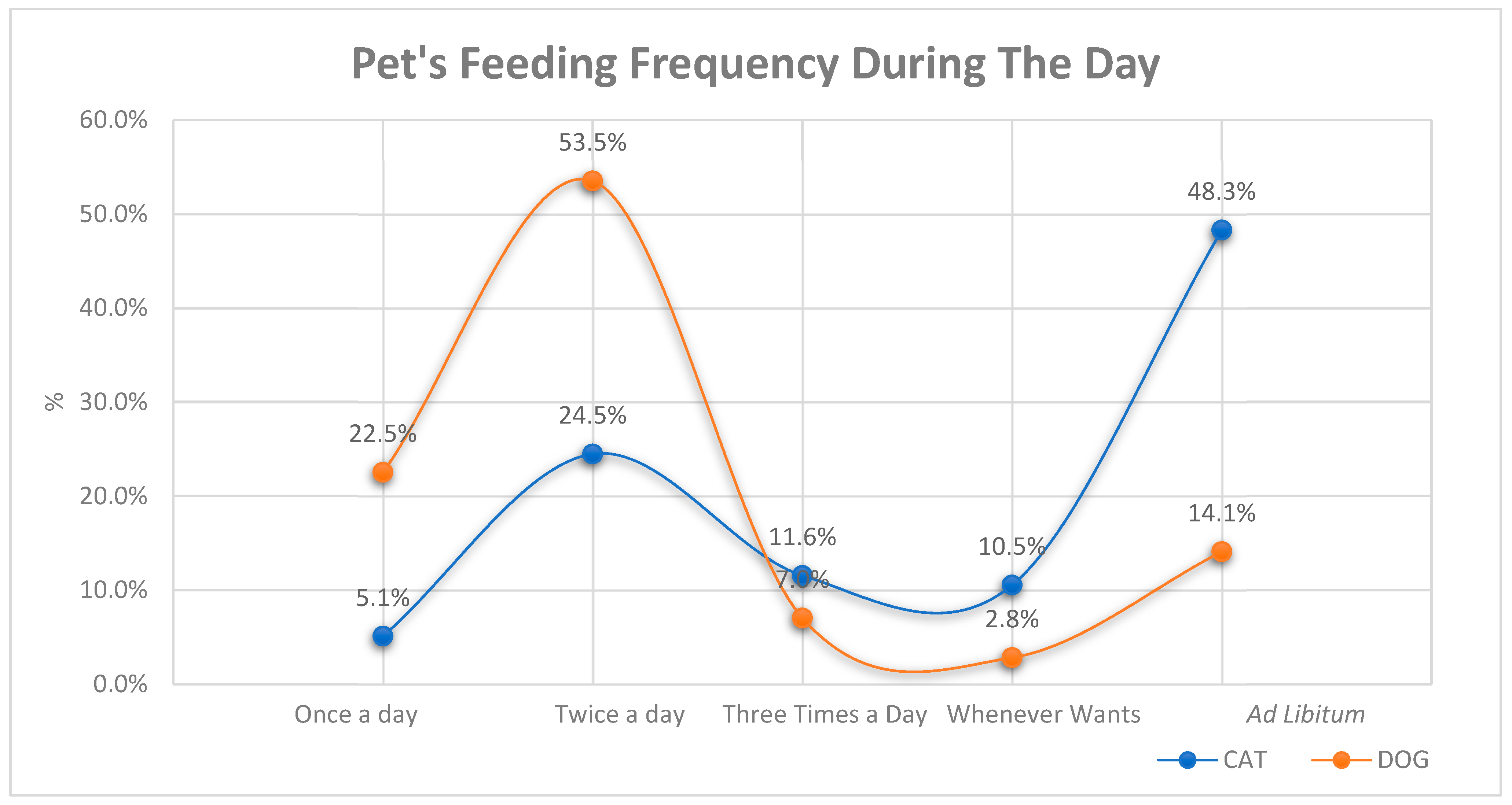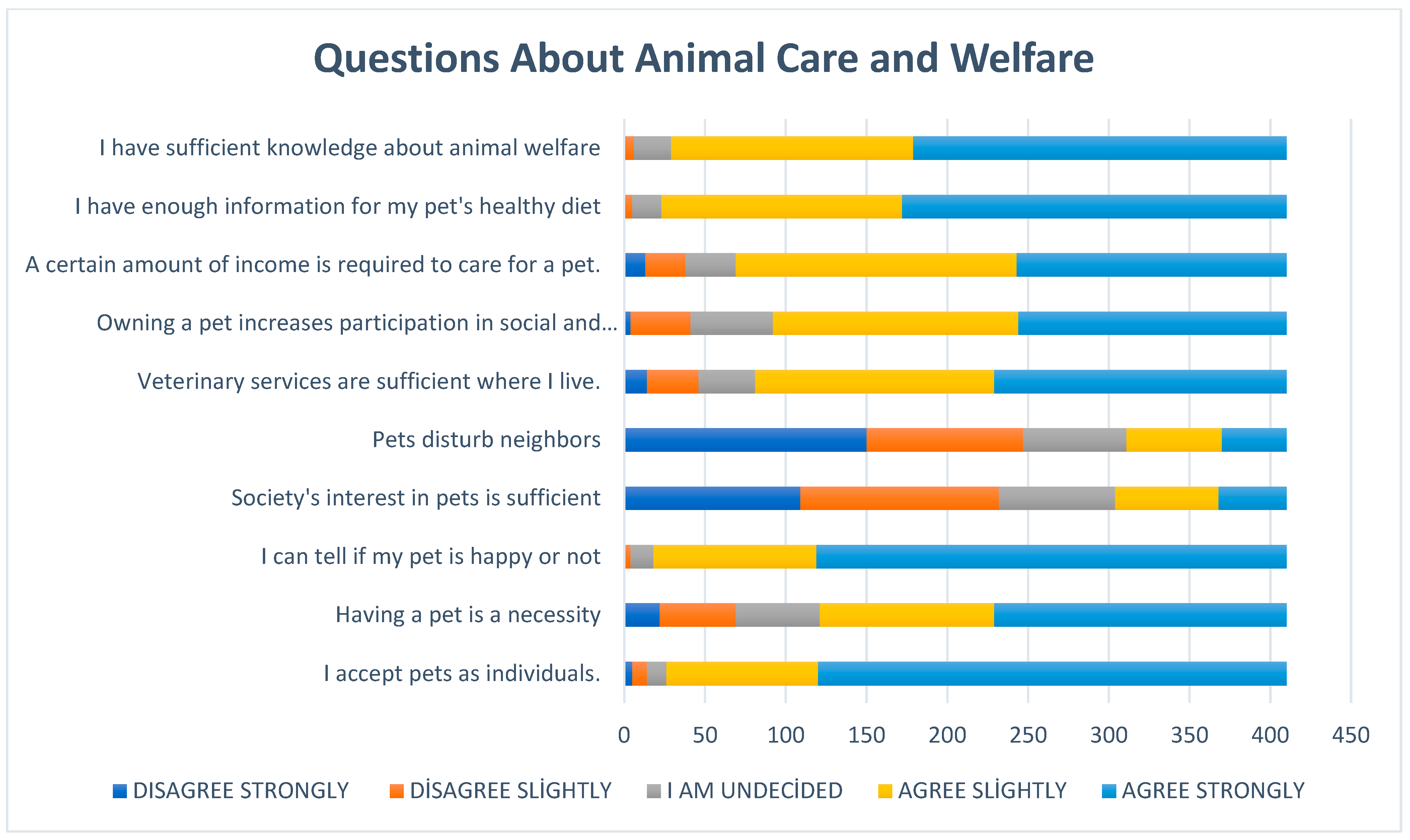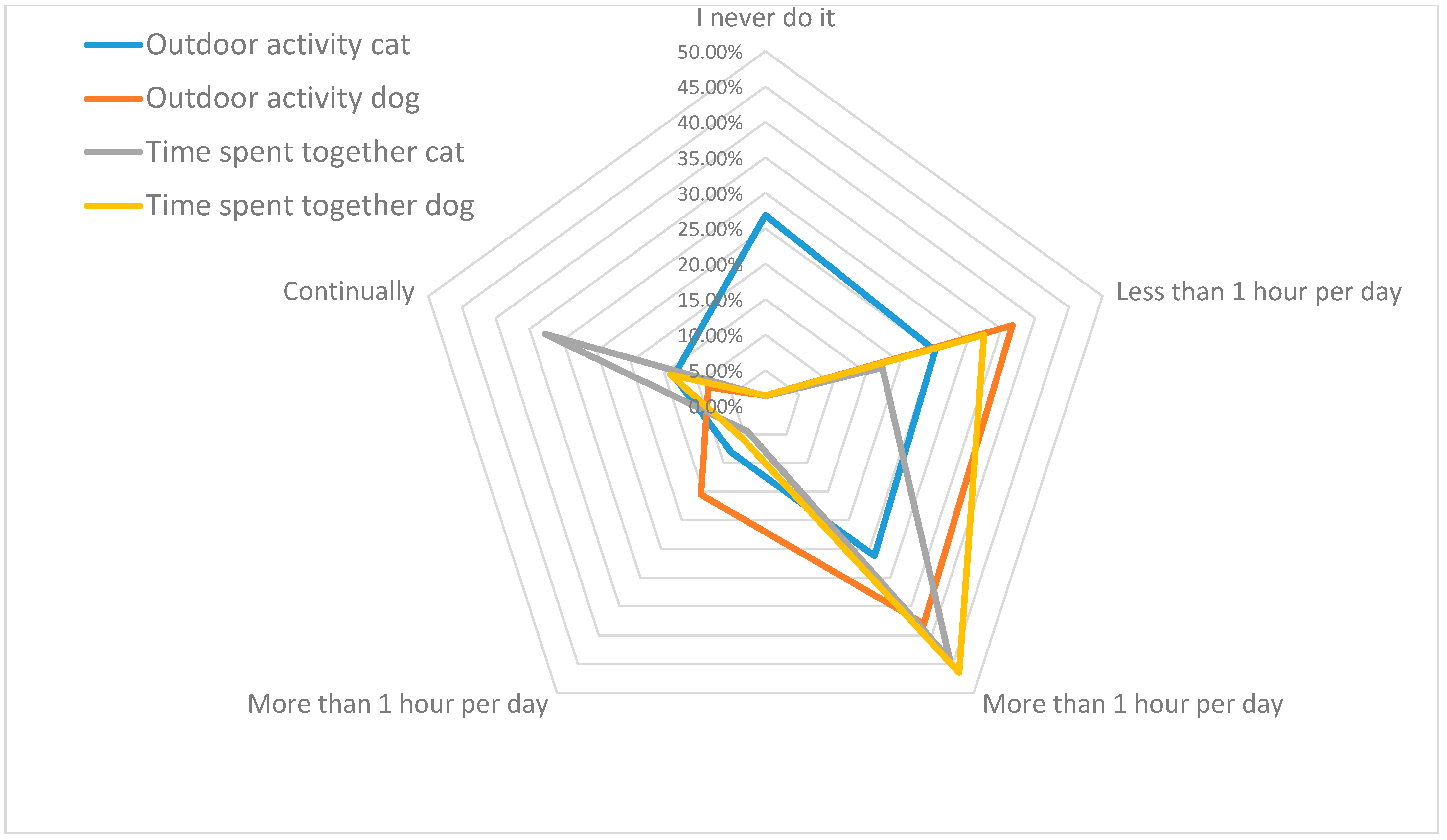Current Perspectives and Practices of Pet Owners in Türkiye on Animal Care, Nutrition, and Welfare
Abstract
Simple Summary
Abstract
1. Introduction
2. Materials and Methods
3. Results
3.1. Demographic Characteristics of Participants and Pet Ownership
3.2. Preferences Regarding Animal Feeding, Care and Related Expenditures
3.3. Animal Welfare Assessment
4. Discussion
4.1. Demographic Data and Pet Ownership
4.2. Pet Care, Feeding Preferences, and Related Expenditures
4.3. Animal Welfare Approaches
5. Conclusions
Author Contributions
Funding
Institutional Review Board Statement
Informed Consent Statement
Data Availability Statement
Acknowledgments
Conflicts of Interest
References
- Jalongo, M.R. Pet keeping in the time of COVID-19: The canine and feline companions of young children. Early Child. Educ. J. 2023, 51, 1067–1077. [Google Scholar] [CrossRef]
- Diverio, S.; Boccini, B.; Menchetti, L.; Bennett, P.C. The Italian perception of the ideal companion dog. J. Vet. Behav. 2016, 12, 27–35. [Google Scholar] [CrossRef]
- Walsh, F. Human–animal bonds I: The relational significance of companion animals. Fam. Process 2009, 48, 462–480. [Google Scholar] [CrossRef] [PubMed]
- Baptista, J.; Blache, D.; Cox-Witton, K.; Craddock, N.; Dalziel, T.; de Graaff, N.; Fernandes, J.; Green, R.; Jenkins, H.; Kahn, S.; et al. Impact of the COVID-19 pandemic on the welfare of animals in Australia. Front. Vet. Sci. 2021, 7, 621843. [Google Scholar] [CrossRef]
- Kogan, L.R.; Erdman, P.; Bussolari, C.; Currin-McCulloch, J.; Packman, W. The initial months of COVID-19: Dog owners’ veterinary related concerns. Front. Vet. Sci. 2021, 8, 629121. [Google Scholar] [CrossRef]
- Parry, N.M. COVID-19 and pets: When pandemic meets panic. Forensic Sci. Int. Rep. 2020, 2, 100090. [Google Scholar] [CrossRef] [PubMed]
- O’Brien, P. The Growing Financial Implications of the Pet Industry. American Pet Products Association 2024. Available online: https://americanpetproducts.org/blog/the-growing-financial-implications-of-the-pet-industry (accessed on 28 October 2024).
- Ministry of Agriculture and Forestry. Animal Registration Statistics from the PETVET System. 2025. Available online: https://hbsapp.tarbil.gov.tr/Modules/KKBS/Reports/KKBSAnimalCountReport.aspx (accessed on 3 January 2025).
- Field, A. Discovering Statistics Using IBM SPSS Statistics, 4th ed.; Sage Publications: London, UK, 2013. [Google Scholar]
- FEDIAF. Annual Review 2024: European Pet Food Industry; FEDIAF: Brussels, Belgium, 2025; Available online: https://europeanpetfood.org/wp-content/uploads/2024/06/FEDIAF-Annual-Review-2024_Online.pdf (accessed on 18 June 2025).
- Reese, L.A.; Jacobs, J.; Gembarski, J.; Opsommer, C.; Walker, B. COVID-19 animal breeding boom: Temporary or imaginary? Animals 2022, 12, 1325. [Google Scholar] [CrossRef]
- Applebaum, J.W.; Peek, C.W.; Zsembik, B.A. Examining US pet ownership using the General Social Survey. Soc. Sci. J. 2023, 60, 110–119. [Google Scholar] [CrossRef]
- Naughton, V.; Grzelak, T.; Mulhern; Moffett, R.; Naughton, P. Caring practices of pet cat and dog owners in Northern Ireland vs potential implications for animal health and welfare. Anim. Welf. 2021, 30, 131–144. [Google Scholar] [CrossRef]
- Kirk, C.P. Dogs have masters, cats have staff: Consumers’ psychological ownership and their economic valuation of pets. J. Bus. Res. 2019, 99, 306–318. [Google Scholar] [CrossRef]
- Zhang, W.; Cao, H.; Lin, L. Analysis of the future development trend of the pet industry. In Proceedings of the 7th International Conference on Financial Innovation and Economic Development (ICFIED 2022), Harbin, China, 21–23 January2022; pp. 1682–1689. [Google Scholar] [CrossRef]
- Wolf, C.A.; Lloyd, J.W.; Black, J.R. An examination of US consumer pet related and veterinary service expenditures, 1980–2005. J. Am. Vet. Med. Assoc. 2008, 233, 404–413. [Google Scholar] [CrossRef]
- Wongsaengchan, C.; McKeegan, D.E. The views of the UK public towards routine neutering of dogs and cats. Animals 2019, 9, 138. [Google Scholar] [CrossRef]
- Vinassa, M.; Vergnano, D.; Valle, E.; Giribaldi, M.; Nery, J.; Prola, L.; Bergero, D.; Schiavone, A. Profiling Italian cat and dog owners’ perceptions of pet food quality traits. BMC Vet. Res. 2020, 16, 131. [Google Scholar] [CrossRef]
- Boya, U.O.; Dotson, M.J.; Hyatt, E.M. A comparison of dog food choice criteria across dog owner segments: An exploratory study. Int. J. Consum. Stud. 2015, 39, 74–82. [Google Scholar] [CrossRef]
- Simonsen, J.E.; Fasenko, G.M.; Lillywhite, J.M. The value-added dog food market: Do dog owners prefer natural or organic dog foods? J. Agric. Sci. 2014, 6, 86–94. [Google Scholar] [CrossRef]
- Schleicher, M.; Cash, S.B.; Freeman, L.M. Determinants of pet food purchasing decisions. Can. Vet. J. 2019, 60, 644–649. [Google Scholar] [PubMed]
- Laflamme, D.P.; Abood, S.K.; Fascetti, A.J.; Fleeman, L.M.; Freeman, L.M.; Michel, K.E.; Bauer, C.; Kemp, B.L.E.; Van Doren, J.R.; Willoughby, K.N. Pet feeding practices of dog and cat owners in the US and Australia. J. Am. Vet. Med. Assoc. 2008, 232, 687–694. [Google Scholar] [CrossRef]
- O’Halloran, C.; Cerna, P.; Barnicoat, R.; Caney, S.M.; A Gunn-Moore, D. How and why pet cats are fed the way they are: A self-reported owner survey. J. Feline Med. Surg. 2024, 26, 1098612X231209894. [Google Scholar] [CrossRef]
- Kraft, W. Geriatrics in canine and feline internal medicine. Eur. J. Med. Res. 1998, 3, 31–41. [Google Scholar]
- Prata, J.C. Survey of pet owner attitudes on diet choices and feeding practices for their pets in Portugal. Animals 2022, 12, 2775. [Google Scholar] [CrossRef]
- Li, P.; Wu, G. Characteristics of nutrition and metabolism in dogs and cats. In Nutrition and Metabolism of Dogs and Cats; Wu, G., Ed.; Advances in Experimental Medicine and Biology; Springer: Cham, Switzerland, 2024; pp. 55–98. [Google Scholar] [CrossRef]
- Michel, K.E.; Willoughby, K.N.; Abood, S.K.; Fascetti, A.J.; Fleeman, L.M.; Freeman, L.M.; Laflamme, D.P.; Bauer, C.; Kemp, B.L.E.; Van Doren, J.R. Attitudes of pet owners toward pet foods and feeding management of cats and dogs. J. Am. Vet. Med. Assoc. 2008, 233, 1699–1703. [Google Scholar] [CrossRef]
- Petison, P.; Lekcharoensuk, C. Cats versus dogs—The impact of species on owner feeding. Vet. Integr. Sci. 2019, 17, 161–169. Available online: https://he02.tci-thaijo.org/index.php/vis/article/view/152302 (accessed on 3 January 2025).
- Duncan, I.J.H. Animal welfare defined in terms of feelings. Acta Agric. Scand. Sect. A Anim. Sci. Suppl. 1996, 27, 29–35. [Google Scholar]
- Worthington, M. Ecologically, ethologically, and ethically sound environments for animals: Toward symbiosis. J. Agric. Ethics 1989, 2, 323–347. [Google Scholar] [CrossRef]
- Sanders, C.R. Understanding dogs: Caretakers’ attributions of mindedness in canine–human relationships. J. Contemp. Ethnogr. 1993, 22, 205–226. [Google Scholar] [CrossRef]
- Beck, A.M.; Katcher, A.H. Between Pets and People: The Importance of Animal Companionship; Purdue University Press: West Lafayette, IN, USA, 1996. [Google Scholar]
- Voith, V.L. Animal behavior problems: An overview [cats, dogs]. Vet. Clin. N. Am. Small Anim. Pract. 1983, 12, 571–585. [Google Scholar]
- McNicholas, J.; Gilbey, A.; Rennie, A.; Ahmedzai, S.; Dono, J.-A.; Ormerod, E. Pet ownership and human health: A brief review of evidence and issues. BMJ 2005, 331, 1252–1254. [Google Scholar] [CrossRef] [PubMed]
- McConnell, A.R.; Lloyd, E.P.; Humphrey, B.T. We Are Family: Viewing pets as family members improves wellbeing. Anthrozoös 2019, 32, 459–470. [Google Scholar] [CrossRef]
- Bouma, E.M.; Reijgwart, M.L.; Dijkstra, A. Family member, best friend, child or ‘just’ a pet: Owners’ relationship perceptions and consequences for their cats. Int. J. Environ. Res. Public Health 2021, 19, 193. [Google Scholar] [CrossRef]
- Herzog, H.A. Gender differences in human–animal interactions: A review. Anthrozoös 2007, 20, 7–21. [Google Scholar] [CrossRef]
- Phillips, C.J.C.; Izmirli, S.; Aldavood, S.J.; Alonso, M. An international comparison of attitudes toward animals and the factors that influence them. J. Appl. Anim. Welf. Sci. 2012, 15, 254–270. [Google Scholar] [CrossRef]
- Serpell, J.A. Factors influencing human attitudes to animals and their welfare. Anim. Welf. 2004, 13 (Suppl. S1), 145–151. [Google Scholar] [CrossRef]
- McNicholas, J.; Collis, G.M. Dogs as catalysts for social interactions: Robustness of the effect. Br. J. Psychol. 2000, 91, 61–70. [Google Scholar] [CrossRef] [PubMed]
- Ahmed, O.S.; ALRawashda, A.Z.; Al Arab, A.R.; Ahmed, A.S. Statistical Analysis of Pet Ownership and Care Expenses in Urban Families of Ajman, UAE. J. Stat. Appl. Pro. 2025, 14, 461–468. [Google Scholar] [CrossRef]
- FAS Riyadh Staff. An Overview of the Pet Food Market in Saudi Arabia; USDA Foreign Agricultural Service: Riyadh, Saudi Arabia, 2025; Report Number: SA2025-0005. [Google Scholar]
- González Ramírez, M.T.; Landero Hernández, R. Pet–human relationships: Dogs versus cats. Animals 2021, 11, 2745. [Google Scholar] [CrossRef]




| Data | Category | Frequency (n) | Percentage (%) |
|---|---|---|---|
| Gender of Participants (n = 410) | Male | 169 | 41.2 |
| Female | 241 | 58.8 | |
| Pet Owner Age (n = 410) | Age 18–25 | 50 | 12.2 |
| Age 26–40 | 201 | 49.0 | |
| Age 41–65 | 153 | 37.3 | |
| Age 66–79 | 6 | 1.5 | |
| Age 80 and over | 0 | 0.0 | |
| Pet Owner’s Education Level (n = 410) | Primary education | 8 | 2.0 |
| High school | 46 | 11.2 | |
| Bachelor | 228 | 55.6 | |
| Master’s or Doctorate | 128 | 31.2 |
| Data Answers | Frequency (n) | Percentage (%) | |
|---|---|---|---|
| Type of House (n = 410) | Apartment house | 323 | 78.7 |
| House with garden | 87 | 21.3 | |
| Number of People Living in the House (n = 410) | Alone | 28 | 6.8 |
| 2 people | 70 | 17.1 | |
| 3 people | 101 | 24.6 | |
| 4 people | 116 | 28.3 | |
| 5 or above people | 95 | 23.2 | |
| Pet Owner’s Monthly Household Income (n = 410) | Less than USD 500 | 22 | 5.4 |
| USD 501–1470 | 140 | 34.1 | |
| USD 1471–2940 | 179 | 43.7 | |
| More than USD 2940 | 69 | 16.8 | |
| Pet Care and Feeding Expenses at Home (monthly expenditure) (n = 410) | Less than USD 30 | 105 | 25.6 |
| USD 31–90 | 206 | 50.2 | |
| USD 91–150 | 65 | 15.9 | |
| USD 151–300 | 30 | 7.3 | |
| More than USD 300 | 4 | 1.0 | |
| Reasons for Adopting a Pet (n = 410) | For support/protection | 5 | 1.2 |
| Need for friendship | 38 | 9.2 | |
| My children want it | 88 | 21.4 | |
| Because I love animals | 279 | 68.1 | |
| Data | Answers | Frequency (n) | Percentage (%) |
|---|---|---|---|
| Type of Pet (n = 410) | Cat | 294 | 71.7 |
| Dog | 71 | 17.3 | |
| Both cat and dog | 45 | 11.0 | |
| Number of Pets (n = 410) | 1 Pet | 277 | 67.6 |
| 2 Pets | 56 | 13.6 | |
| 3 or more pets | 77 | 18.8 | |
| Pet Gender (n = 410) | Male | 189 | 46.1 |
| Female | 221 | 53.9 | |
| How Many Years Have You Been a Pet Owner? (n = 410) | 1–3 years | 172 | 42.0 |
| 4–10 years | 168 | 40.9 | |
| More than 10 years | 70 | 17.1 | |
| Pet Neutered? (n = 410) | Yes | 293 | 71.5 |
| No | 117 | 28.5 | |
| How Do You Evaluate Your Pet’s Weight? (n = 410) | Very weak | 1 | 0.2 |
| Weak | 16 | 4.0 | |
| Ideal | 318 | 77.6 | |
| Fat | 63 | 15.4 | |
| Overweight | 12 | 3.0 |
| Data | Answers | Frequency (n) | Percentage (%) |
|---|---|---|---|
| Pet’s Diet (n = 410) | Commercial food only | 196 | 47.8 |
| Only homemade food | 16 | 4.0 | |
| Commercial and homemade food | 35 | 8.5 | |
| Mostly commercial food with some homemade | 146 | 35.6 | |
| Mostly homemade with some commercial food | 17 | 4.1 | |
| Preferred Commercial Food Type (n = 394) * | Dry foods | 375 | 95.1 |
| Wet foods | 5 | 1.3 | |
| Semi-watery foods | 14 | 3.6 | |
| Preferred Commercial Food Quality (n = 394) * | Economical foods | 69 | 17.5 |
| Premium foods | 151 | 38.3 | |
| Super-premium foods | 174 | 44.2 | |
| Where to Purchase Commercial Food (n = 394) * | On the internet | 177 | 44.9 |
| From markets | 33 | 8.4 | |
| From pet shops | 88 | 22.3 | |
| From the veterinary clinic | 96 | 24.4 | |
| Reasons for Choosing Commercial Food (n = 394) * | Price | 19 | 4.8 |
| My pet loves | 111 | 28.1 | |
| Content of food | 201 | 51.0 | |
| Brand of food | 24 | 6.1 | |
| Recommendation (friend, veterinarian, etc.) | 36 | 9.1 | |
| Other reasons | 3 | 0.8 |
Disclaimer/Publisher’s Note: The statements, opinions and data contained in all publications are solely those of the individual author(s) and contributor(s) and not of MDPI and/or the editor(s). MDPI and/or the editor(s) disclaim responsibility for any injury to people or property resulting from any ideas, methods, instructions or products referred to in the content. |
© 2025 by the authors. Licensee MDPI, Basel, Switzerland. This article is an open access article distributed under the terms and conditions of the Creative Commons Attribution (CC BY) license (https://creativecommons.org/licenses/by/4.0/).
Share and Cite
Çelik, S.; Muruz, H.; Çelik, S.; Can, M.F.; Çelik, M. Current Perspectives and Practices of Pet Owners in Türkiye on Animal Care, Nutrition, and Welfare. Vet. Sci. 2025, 12, 904. https://doi.org/10.3390/vetsci12090904
Çelik S, Muruz H, Çelik S, Can MF, Çelik M. Current Perspectives and Practices of Pet Owners in Türkiye on Animal Care, Nutrition, and Welfare. Veterinary Sciences. 2025; 12(9):904. https://doi.org/10.3390/vetsci12090904
Chicago/Turabian StyleÇelik, Salih, Habip Muruz, Seda Çelik, Mehmet Ferit Can, and Mehmet Çelik. 2025. "Current Perspectives and Practices of Pet Owners in Türkiye on Animal Care, Nutrition, and Welfare" Veterinary Sciences 12, no. 9: 904. https://doi.org/10.3390/vetsci12090904
APA StyleÇelik, S., Muruz, H., Çelik, S., Can, M. F., & Çelik, M. (2025). Current Perspectives and Practices of Pet Owners in Türkiye on Animal Care, Nutrition, and Welfare. Veterinary Sciences, 12(9), 904. https://doi.org/10.3390/vetsci12090904











